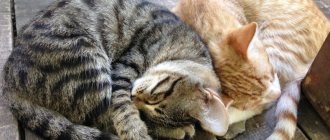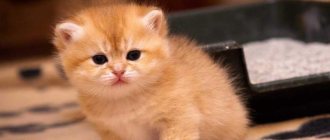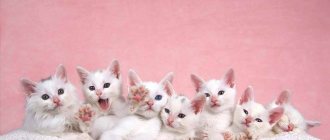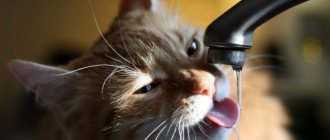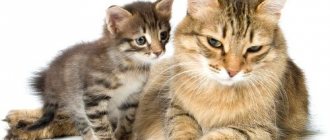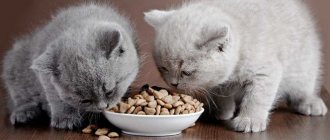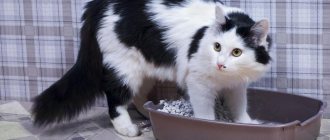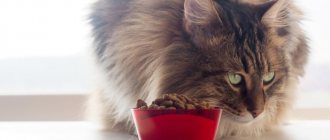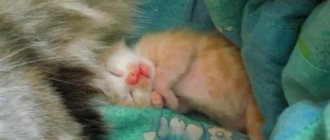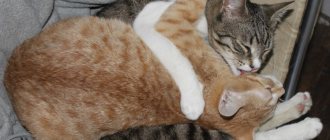Features of digestion depending on age
Cats belong to the order of carnivores, the class of mammals.
Immediately after birth, the baby needs mother's milk. With it, he receives micronutrients, proteins, vitamins, fats and, most importantly, immunoglobulins, which form the immune system of the future predator. The mother feeds the offspring until they are three months old. The enzyme lactase is produced in the small intestine of kittens. It is responsible for the digestion of milk sugar (lactose).
Mother's milk
From a month on, the cubs gradually begin to taste meat. The amount of breast milk consumed decreases, but it still takes up a significant part of the diet. As the kitten grows up, serious changes occur in its body. Lactase production decreases. The digestive system produces more and more proteases necessary for the breakdown of proteins.
Three months is the age when a kitten becomes an adult and stops receiving milk from its mother. By this point, the body has already adjusted to a meat diet, and lactase practically ceases to be produced. There is not enough enzyme to process lactose, so milk causes unpleasant symptoms (pain, diarrhea) in most adults.
Features of mother feeding kittens
Almost immediately after lambing, the cat produces colostrum. This is a milk-like substance containing a large number of useful components. Colostrum is especially rich in antibodies, which provide immunity to newborns in the first days of life. Gradually, the level of antibodies decreases, and colostrum becomes mother's milk. For newly born babies, it is the main food for several weeks. Only with the secretion of the mammary gland can kittens receive proteins, fats, carbohydrates and substances necessary for the normal development of the body.
Details
Basic Rules
We present the basic rules, following which you can figure out how to raise and feed a 1-month-old kitten without a cat at home:
1. Food for a one-month-old kitten should have a liquid consistency. Solid inclusions and pieces should be avoided. The kitten will hardly be able to digest such food. 2. When feeding a small kitten for up to a month, use various feeding devices. Bottles with rubber nipples can serve as such devices. 3. Each new product is introduced into the diet gradually and in small portions. 4. Do not overfeed your baby. Control the amount of food in the bowl. 5. Introduce new foods into the kitten’s diet not immediately, but gradually. Give each new product every 3-4 days.
IMPORTANT: Provide the kitten with clean drinking water in the required quantity.
How to train a one-month-old kitten to eat on its own
The kitten begins to show interest in adult food at the age of 3 weeks.
He watches with interest how other animals eat. Complementary feeding should begin with dairy products. Pour milk into a saucer, dip your finger in it and let the kitten lick it. The baby will understand that it’s delicious and will reach for the cup himself.
Then you can poke the kitten's muzzle into the milk, but be careful not to choke. In any case, give the kitten freedom of movement and freedom of choice. He himself will reach for a cup of milk and start lapping it up. Don't think that you will succeed the first time. Be patient and repeat the procedure again. It is normal for the kitten to snort and sneeze.
A baby kitten can get its paws right into the bowl. To wean your kitten from such a bad habit, wipe its wet paws every time.
Hold him by the neck so he doesn't go all the way into the bowl. Be patient with your little pet and after a few days the kitten will learn to eat on its own. The owner of a kitten is always conflicted about whether it is better to feed the kitten dry food or natural food.
Cat breeders debate the benefits all the time. Ready-made cat food is a balanced product. The manufacturer adds everything you need to it: vitamins, healthy additives and microelements. From the point of view of veterinarians, dry food is worthy food for an animal.
Cautions
But with any approach, you need to recall important features:
- If you start feeding your kitten natural products, do not add dry food to its food. The fact is that the process of digesting dry food and natural food is different. Therefore, if you do not want your animals to encounter problems such as gastroenteritis and gastrointestinal colic, then do not feed natural food and dry food at the same time.
- You should not feed your kitten with industrial food of different brands at the same time, this will either lead to an excess of some vitamins or to vitamin deficiency. Digestive problems are also possible.
- Don’t skimp on your pet’s health, buy proper and high-quality food. The kitten should be fed with a product of the “Premium” and “Superpremium” classes.
If you decide to feed your kitten natural food, then adhere to the following rules:
- Diet variety. If from an early age an animal gets used to one type of food, then in the course of its life it will hardly be possible to accustom it to another. Offer your kitten a variety of foods.
- You should not feed your kitten food from your table. Human food contains salt and spices that are harmful to cats.
So what should you feed a one-month-old kitten, besides milk?
You can give complementary foods in the form of cottage cheese. Stir cottage cheese with milk until it reaches a consistency similar to sour cream. The next product that you will introduce into the diet of a month-old kitten is chicken yolk, but it should also be mixed with milk. Porridge with meat and milk broths, soups with broth without spices, and boiled vegetables are good for a kitten.
You can use different products, the main thing is that they are not greasy and are well chopped. Kittens should not be given meat from fatty animals, such as pork, goose, and duck. Add organ meats to your food. Meat should not be given to a kitten raw; it must be boiled first. Fish should not be given to cats often. Frequent consumption of fish leads to kidney disease. For castrated animals, fish is excluded from the diet altogether.
The food of a small kitten should be close to natural. Food should be warm and natural. Do not feed foods that are too hot or very cold. Make sure that the kitten always has clean water.
Feeding regimen or how many times should a kitten be fed 1 month old:
1. Kittens up to two weeks old are fed at least 7 times a day. All feedings are divided into equal time intervals. 2. Kittens aged from 2 weeks to 1 month are allowed to eat 6 times a day. 3. A kitten older than 1 month should receive food 6 times a day in small portions.
A single serving of food for a one-month-old kitten is 30 ml per 100 g of weight. A kitten over 1 month of age is given 50 ml per 100 g of food weight at a time.
How long does it take for a cat's milk to burn out?
The time it takes for a cat to lose or burn out milk under normal conditions depends on many factors, including how you distribute the kittens.
It is best to separate kittens from the cat one at a time, 3-4 months after birth, taking a break of 3-4 days. It is advisable to prepare the cat and kittens 2-3 days before this event. Several times a day, kittens are taken away from the cat for 1-2 hours in another room, leaving them with food, water and cat litter. This way they gradually get used to independence.
If the kittens were given away unexpectedly
But what if for some reason the kittens had to be given away at the same time or too early?
In this case, on the first day you need to not give her food and water, and then begin to gradually increase their amount. If the cat is too worried, looking for and calling kittens, give her a special sedative for cats, pay more attention, pet her, create a calm environment in the house. At the same time, to stop lactation, you need to reduce the amount of water and food consumed by the cat.
You can follow this scheme: on the first day, do not give the cat food at all and give only half of the amount of water it usually consumes, on the second day - give a quarter of the usual portion and half a portion of water, on the third day you can give as much water as it wants, and a little more food than the previous day.
Can kittens have milk from a cow?
If, for a number of reasons, a kitten can no longer feed on mother’s milk, the owner is faced with the task of choosing the most suitable analogue. The first thing that comes to mind is cow's milk. This product is widely represented on the market, it is affordable and can be found in any store. But can you give it to a kitten? Unfortunately, there are many reasons why this choice should be abandoned.
Cow's milk is intended for newborn calves. Its composition is rich in vitamins and beneficial microelements, many of which are suitable for cat babies. But some substances are not needed by the kitten’s body and are even dangerous:
- the protein contained in cow's milk can cause diarrhea or allergies;
- estrogen is a female hormone present in the milk of a pregnant cow, which negatively affects the kitten’s hormonal levels;
- antibiotics that cows receive on farms can cause dysbiosis;
- Some of the pesticides contained in cow feed end up in the milk and can cause severe poisoning in a kitten;
- pasteurized dairy products from the store are practically devoid of nutrients and beneficial substances.
Feeding with cow's milk
Is it possible to rewind a cat to burn off the milk?
Pregnancy, childbirth and lactation of cats are special and exciting events, and therefore are often surrounded by various superstitions that have come down to us from the times when it was not possible to buy special food for a cat, take it to a veterinarian, or find a medicine.
For example, people often ask how to properly rewind a cat so that the milk burns out. This issue is probably related to the custom of women to bandage their breasts when weaning a baby from breastfeeding. Maybe this method helped someone relieve pain, but there is no scientific evidence that people or cats necessarily need to tighten the mammary glands to stop lactation.
In addition, a cat who has just been separated from her kittens needs care and attention, and attempts to wrap her belly will most likely only frighten the cat and increase stress.
As we have already said, the cessation of lactation is facilitated by proper weaning of kittens and diet - as a rule, if these rules are followed, everything should go well for your pet. If for some reason mastitis begins, then the best solution would be to immediately contact a veterinarian.
Although there are various folk remedies for mastitis, we would not recommend that you treat your cat on your own.
Features of goat milk
Goat's milk is better for kittens than cow's milk. Its composition is more acceptable to their body.
Goat milk has a number of undoubted advantages over cow milk:
- in terms of fat content it is closer to cat fat;
- fats and proteins are easily digestible;
- low-allergenic;
- contains less lactose;
- contains a lot of lacto- and bifidobacteria, which have a positive effect on the intestinal microflora and the digestive process;
- a significantly higher percentage of vitamins and mineral compounds.
If there are no contraindications, kittens can be given goat's milk. To reduce the fat content, it must first be diluted with water.
It is very important to buy the product from trusted farmers, making sure in advance that the goats are healthy, well-nourished and kept in decent conditions.
Is it possible to influence the number of kittens in a litter?
In ordinary life, owners rarely seek to influence a mother cat in order to increase or decrease the number of future newborn kittens. However, this can be done - primarily with the help of special medications that can stimulate the cat to produce more eggs. Consultation with a specialist is required; any independent intervention can be dangerous for the cat.
The likelihood that a cat will be very fertile also increases if she is given vitamins - selenium and E. However, you cannot select vitamins and their dosage yourself; it is important to entrust this to an experienced specialist. Otherwise, there is a risk of harming the cat’s health, disrupting the functioning of its gastrointestinal tract and more.
Milk during feeding
A kitten, left without a mother from the first days, needs adequate nutrition for normal development. The owner's first step is to try to get cat milk for the little pet. To do this, you need to find a nursing cat and give her another baby. If this method fails, it's time to think about an alternative.
Many pet food manufacturers produce special complementary foods that will become the baby’s main diet until he is one month old. These are mixtures that include milk powder, cream, yeast, eggs, as well as all the elements necessary for growth.
The preparation process is simple - pour liquid into the powder and mix thoroughly. Usually a daily supply is prepared immediately, which is kept in the refrigerator to preserve its benefits and freshness. Before feeding, the required amount of the mixture is heated to 38 ⁰C.
Veterinarians recommend adding a little more liquid to the powder than indicated on the package. This will help avoid constipation.
Various feeding mixtures
When making a choice in favor of one or another product that replaces mother's milk for kittens, you need to consider several points:
- the manufacturer and brand must be well-known and have positive reviews from specialists and breeders;
- The breed of the pet largely determines the required calorie content of the mixture;
- fat content – for children the limit value is 9%.
Meat puree can be gradually introduced into the menu of a bottle-fed kitten from the age of one month.
How to teach to eat liquid food from a saucer?
It is better to provide a special milk formula for kittens as food during weaning hours.
Giving cow's milk is not recommended due to frequent cases of indigestion, diarrhea or constipation. It is strictly not recommended to put a kitten's face in a saucer with formula/milk; the baby may inadvertently inhale droplets of liquid and develop pneumonia.
The owner should dip a finger into the liquid and touch the kitten's lips with it. The kitten must lick itself. Repeat the procedure until he begins to lick milk directly from his finger. Then dip your finger in the saucer and hold it there until the kitten comes to the saucer and starts lapping up the milk right from there next to the finger.
General recommendations
- When babies are one month old, teach them to have short but regular separations from their mother. Let the four-legged little one spend a couple of hours a day in his own “house” with dishes, a bed and a toilet.
- If the kitten does not yet know how to eat from a bowl, it is placed on its tummy and fed from a syringe. First remove the needle and gradually squeeze out the liquid contents drop by drop into the mouth so that food does not get into the windpipe. A more convenient feeding device is a bottle purchased at a pet store with a set of nipples.
- Do not deprive a mother cat of all her babies at once. Otherwise, the nurse’s mammary glands will become overcrowded and will hurt. Together with the stress experienced, this will lead to health problems.
- Introduce kittens to the smells of the new home and its inhabitants, including fauna. Periodically sniffing the personal belongings of the owners (T-shirt, T-shirt) and the pet (sheets, toys) will help you get used to the “aura” of your future habitat.
- When parting with the mustache, give the new owner the bedding on which the baby slept in the “father’s house.” Native smells will help the tailed “new resident” feel more confident in an unusual environment.
Read:
How many toes does a cat have on its paws: normal and abnormal
What's wrong with the cat? Possible reasons for abandonment of offspring
How to understand what is wrong with a cat and why she refused kittens? It is important to understand that cats very rarely abandon kittens, since they have highly developed instincts for caring for their offspring. You can understand the reasons by observing the young mother.
If a cat hisses, rushes at the kittens, tries to hit them with her paw or strangle them, most likely the babies were born prematurely and the young mother considers them unviable. In this case, it is useless to insist on the kittens being taken back; it is better to try to feed the babies yourself.
If a cat has given birth for the first time, she may refuse kittens due to severe stress. In this case, there is a chance to “persuade” the young mother to accept the offspring back. Keep a close eye on the cat, she will look for a more reliable shelter for her offspring. Once the cat finds shelter and settles down in it, do everything to move the nest closer to her. If necessary, move furniture, empty cabinets, but give the young mother the opportunity to choose what she considers a safe shelter for her offspring.
A cat may abandon kittens if her health or life is in danger. The most common cause of abandonment of offspring immediately after birth is eclampsia. This condition is life-threatening for the young mother, so it is necessary to contact a veterinarian. Postpartum eclampsia is eliminated by injections of drugs containing calcium.
If a cat has problems with the functioning of the hormonal system, alarming symptoms may appear immediately after birth. Most often, we are talking about the inability to process glucose, as a result of which the young mother falls into a state of shock. Shock can be relieved with insulin, however, be sure to contact your veterinarian for a more accurate diagnosis.
Can adult cats?
Nutritionists call for completely eliminating milk from the animal’s diet for six months. It is at this age that the production of lactase in the cat’s body reaches a minimum, which means that milk sugar will practically not be broken down. This may result in diarrhea and vomiting.
Some cats drink milk into old age without negative consequences. That is, their body continues to produce the necessary enzyme in sufficient doses. But this is rather an exception to the general rule and is associated with the individual characteristics of a particular pet.
Almost all animals like the taste of milk, but the product does not benefit an adult cat. On the contrary, in most cases, consuming the product can lead to poor health:
- the high calorie content of whole milk can disrupt metabolism and cause obesity;
- the high content of lactose and casein interferes with normal absorption, disrupting the functioning of the gastrointestinal tract;
- development of an allergic reaction;
- Lactose intolerance leads to deterioration of digestive functions, bloating, flatulence, diarrhea, and dehydration.
- It was delicious!..
How long does a cat feed kittens?
Cat breeders are often not against the birth of offspring, and some owners of especially valuable breeds even attach great importance to this.
Therefore, they are sensitive not only to the process of pregnancy and childbirth, but are also interested in how much milk the cat feeds the kittens with milk. It is important to note that mother cat milk is of significant importance in the life of a kitten, being an irreplaceable source of nutrients and energy. This means that the owners’ interest in the duration of feeding and its main points is understandable.
Feeding frequency
Like all mammals, colostrum initially appears immediately after birth, which subsequently becomes full-fledged milk. It is from feeding colostrum that kittens develop immunity, so it is very important that they receive these precious drops. In the first few weeks of life, mother's milk will become the only and most important food for kittens, the source of all components essential for growth and normal development.
Newborn blind babies unmistakably find cat nipples that smell of tasty and healthy milk. Kittens have an excellent sense of smell from birth, as does their appetite. Appetite, however, is a sign that they are healthy.
Depending on the age of the kittens, the cat should feed the following number of times per day:
- first week of life – 10-12 times;
- second and third weeks – 8 times;
- fourth and subsequent weeks – 6 times.
Factors influencing duration of feeding
The question of the period of feeding a cat with milk is individual. Veterinarians say that there are a number of factors directly related to this:
- Number of kittens in the litter . A cat can feed a fairly large number of babies with milk. But it is noted that one kitten can receive feeding from its mother for longer than 5 or 6 at a time.
- Individual cat characteristics . Each case is, of course, special. Some may not allow kittens to come near them at all, while other cats feed their kittens with milk even when they are quite large. The duration of milk feeding may also depend on the animal’s mental state, so it is important to create a favorable climate around the giving birth so that the kittens receive their mother’s milk in full.
- Cat health . In addition to the psychological factor, milk feeding is also influenced by the physiological state of the furry parent. If there are complications after childbirth, mastopathy, then she may completely refuse to breastfeed and not allow kittens to come to her. Various diseases, including parasitic ones, can also affect the duration of milk production.
- Mother cat nutrition . The lactation process is quite complex and depends not only on the health of the pet, but also on the nutrition received. Only balanced food makes it possible to replenish the nursing mother’s body with all its needs for minerals, proteins, fats and carbohydrates. As long as the balance is complete, the cat will have milk for as long as possible.
A healthy cat, receiving good nutrition and surrounded by a calm environment, feeds kittens for up to 2.5 months. This figure is conditional and may be more or less. But the first month is very important for babies, because during this entire period milk is their only food.
Introduction of complementary foods
With the onset of the second month of life, kittens can add complementary foods to their diet. At the same time, the cat continues to feed the kitten with mother's milk. Babies develop very quickly, and this alone cannot provide them with adequate nutrition.
Leaving 3-4 meals a day with cat milk, the kittens begin to be given solid food: cottage cheese, chicken fillet, pieces of beef. It is allowed to give cow's milk, diluting it with water.
Gradually adding solid food allows babies to gradually become accustomed to chewing and digesting it. By the age of two or three months, their need for mother's milk disappears. It is not able to provide growing organisms with the complex of necessary elements that are so necessary for normal growth and development.
Lactose intolerance
Milk is the first food for cats, like other mammals. The baby's body secretes enough enzyme to process milk sugars. Gradually, the animal switches to solid food, and lactase production decreases.
Once milk is removed from the diet, the body permanently stops producing the enzyme. This means the animal loses the ability to normally digest dairy products. This explains why adult cats should not drink milk. Their body can no longer process this product.
In animals that are fed milk from childhood, lactase continues to be produced. They can consume the product in small quantities to avoid consequences.
When and how to switch to solid food?
They begin to offer solid food only after babies confidently begin to drink from a saucer. You can offer special balanced food for kittens or make a paste with the consistency of oatmeal from crushed dry food and milk (infant formula). You should bring a finger lubricated with gruel to the kitten’s lips and give him the opportunity to sniff the food. Then you should smear the lips, lightly pushing the food into the mouth. Wait until the kitten tastes, chews and licks. Then you can bring it to the saucer with food and wait until the baby sniffs it out on its own and starts eating without outside help.
After the kittens begin to fully eat only “adult” food, go to the toilet in a tray and can do without the cat’s mother for a long time (age 10-12 weeks), then the offspring can be distributed into the wrong hands.
Feeding procedure
- Sit in a comfortable position, lay a bedding on your knees - a towel, a diaper;
- The kitten needs to be placed in the same position as when sucking milk from a cat - standing, lying on its stomach with an elevated position;
- Squeeze out a little product so that the kitten feels the smell, takes the pacifier in its mouth, if this does not happen, carefully insert it into the mouth, then instinct will react;
- You need to feed a newborn with a pipette; you should not squeeze out the contents. It is necessary for him to develop a sucking instinct; he does it himself;
- After about 7 days, you need to switch to a syringe, but squeeze out the milk slowly so as not to choke.
Kitten feeding schedule. Up to the third week inclusive
For the first five days, a newborn kitten needs to be fed every 2-3 hours, day and night. The daily norm is 30 ml of the mixture per 100 grams of weight. Further, until they reach the age of two weeks, the kittens are fed every 4 hours throughout the day. The amount of food increases to 40 ml per 100 grams of weight. During this time, kittens need some kind of cat's milk substitute. The milk of any mammal is intended exclusively for the cubs of its species, so you should never give kittens any kind of milk in its pure form. You can use cat milk substitutes, which are sold in pet stores, or prepare your own formula. To prepare it you will need 4 parts of boiled cow's (or goat's) milk and one part of egg white. The ingredients must be mixed until a homogeneous mass is obtained. If kittens cannot tolerate cow's milk (you will notice this immediately because problems with stool will begin), you can try giving them infant formula (very weakly diluted). It is convenient to feed kittens using a pipette or a medical syringe without a needle. You need to give them the mixture very carefully, because if it gets into the lungs, the kitten will choke. If this suddenly happens, immediately turn him upside down to clear the airways. In addition, care must be taken to ensure that no air gets into the kitten’s stomach while eating. To do this, hold the pipette or syringe at an angle of approximately 45 degrees. After feeding, kittens need to gently massage their tummies with a dampened piece of cloth to stimulate digestion and help them release their natural needs. Under normal conditions, this is done by the mother cat. The kitten should “go to the toilet” 2-3 times a day. You can store the finished milk mixture in the refrigerator for no longer than a day; syringes and pipettes used for feeding must be boiled regularly.
Unless your kittens are abandoned or separated from their mother, their weight will still need to be monitored. Slow weight gain indicates that they are undernourished. If kittens begin to suck the finger extended to them and squeak all the time, they are hungry. If you notice this, increase the amount of food for the mother cat. Sometimes some kittens get enough milk, while others remain hungry. In this case, hungry kittens should be placed closer to the belly of a nursing cat. If the cat does not have enough milk for all the kittens, you need to start feeding them additionally.
Temperature regime for newborn kittens
It is necessary to feed orphaned kittens as early as possible, so that no more than a day passes after birth. But even more important is to keep them warm. Newborns cannot regulate their body temperature and are at risk of hypothermia outside their cozy den.
A heating pad will replace your mother's warm side. If you don’t have a special rubber heating pad, you can take a regular plastic bottle. The container is filled with boiling water and wrapped in a terry towel in several layers. This way the kitten will not get burned, and the water will cool more slowly. Depending on the temperature in the room, the hot water will have to be changed. In an apartment where it is about 20o, the heating pad keeps warm for about 6 hours. If the kittens are restless and huddle together, check the temperature of the heating pad.
For the first week, you should always have a heating pad on, change the water even at night. It becomes unnecessary when kittens reach one month of age. But knowing the love of cats for warmth, you can continue to apply the heating pad longer.
If there are a lot of kittens, then the box should be large. But then the blind kitten may get lost, bumping into the wall, and freeze. To prevent this from happening, you need to place bottles of hot water against each wall, and leave a free space in the center where the kittens can crawl. The cubs can simply snuggle up to the heating pad, or they can climb onto it and sleep on top.
What to do in this situation
If your pet is healthy but ignores newborns, you should try to “persuad” her. You should build a nest in a quiet, warm corner and place the mother and her offspring there. There should be a tray, a cup of food and clean water nearby so that the animal does not go far from the house. It is necessary to take an active part in the pet’s life: monitor the animal’s condition, body temperature, check for the presence of milk, lumps, and discharge from the genitals. Often, an infection in the uterine cavity becomes the reason why a cat does not feed kittens. It is advisable to invite a veterinarian home so that he can examine the mother and newborn kittens for diseases and congenital pathologies. You can find a wet nurse for the babies or take the responsibility of feeding into your own hands.
Attention! You cannot touch kittens without gloves. Human intervention can cause a cat to abandon its babies.
Setting up a den for newborn kittens
Even the tiniest, still blind kittens can scatter in search of their mother, food or a source of warmth. To avoid trouble, it is necessary to exclude the possibility of escaping from the “nest”. The traditional, time-tested option is a cardboard box. Newborn kittens will not soon be able to get out of it on their own. The box should not be a shoe box, but with high walls.
Cardboard is a warm and safe material, and if the box becomes unusable, you can simply throw it away and replace it with a new one. An alternative is a deep plastic box or container, but in this case the ventilation is worse, and the container itself will have to be washed and disinfected periodically.
Place bedding on the bottom. A convenient option is disposable absorbent diapers, but the downside is that it can bunch up and clump if you do not attach it with tape or an adhesive edge. Fleece has proven itself to be excellent - it dries quickly, is warm and soft. Woolen products are absolutely not suitable, although they are often placed on kittens for “entourage”. The claws may get tangled in the fur, causing injury to the kitten. In addition, babies acquire the bad habit of sucking wool and may swallow thread.
Creating conditions for kittens
To raise a kitten without a cat, you will have to replace the mother not only in the feeding process. You need to provide the kittens with a place to sleep and play, learn how to wash the kitten, and give it a massage.
- A place to sleep. You can use a small box as a sleeping place. Place soft cloths, baby diapers or towels there. During the first weeks of life, the temperature of the kittens' bed should be similar to the mother cat's body temperature. The room temperature will need to be maintained at 29-32°C, then gradually reduced to 24°C. If kittens are cold, use a warm water bottle or a small heater as a heating pad. The sleeping area should be clean, so wash the bedding promptly, being careful not to use chemical cleaners.
- Washing and massage. It is best to wash the kitten with a cotton pad or soft cloth soaked in warm water. When washing, imitate the movements of a mother cat - move along the kitten’s fur in one direction, from top to bottom. Before and after each feeding, it is necessary to massage the kitten's tummy to stimulate digestion and bowel movements.
Is it true that artificial kittens get sick more often?
There is a persistent myth according to which kittens deprived of their mother's milk will suffer from some illness throughout their lives. Allegedly, they have extremely weak immunity and a digestive system that has been torn since childhood.
As usual, there is some truth here. Breast milk is really difficult to replace with artificial formula, and the consequences of such feeding can appear years later. But think about this - millions of human babies are raised on formula and are no different from those people who were breastfed as children.
Kittens receive protection from infections from mother's milk only in one case - if antibodies to viruses are in the blood of the cat itself. This is called colostral immunity. If a nursing cat has not been vaccinated, then her kittens are just as defenseless against viruses as bottle-fed kittens. Babies receive preventive vaccinations as early as possible (the first at 2 months with revaccination at 3 months). And complementary foods are introduced as quickly as possible, nevertheless continuing to give a cat's milk substitute for up to 1.5-2 months.
Rumors about the illness of orphaned kittens have a different background. For example, a pregnant cat was starving, which prevented the correct formation of the fetuses.
If the cat lived in good conditions, and the kittens received good genes from both parents, then artificial feeding will not prevent the babies from growing into beautiful and healthy animals.
Is it possible to keep newborn kittens together?
If there are several kittens, they are usually kept together. This makes it easier for babies to stay warm by snuggling together. Living warmth and the presence of relatives calms and creates a feeling of security.
But there are exceptions to every rule. During the first week, kittens should not be left with each other unattended, as their umbilical cord has not yet healed. Up to the age of one month, observe how babies interact with each other. Without round-the-clock access to the mother's breast, hungry kittens can cling to each other. This can be very dangerous - babies leave each other serious bruises, most often in the genital area and abdomen. They can suck ears and tails. If nothing is done, inflammation begins, especially in weak kittens.
To prevent kittens from sucking each other, they need to be fed and picked up as often as possible. But most often we have to separate the kids. Be careful.
The sucking reflex persists in orphan kittens for a very long time. Sometimes a cat raised without a mother sucks the owners fingers, earlobes, clings to the skin of the hands or chews hair until death.
